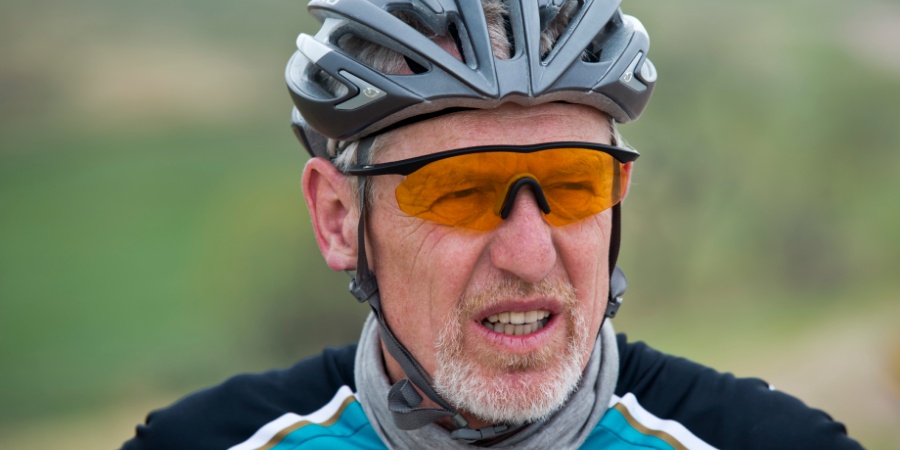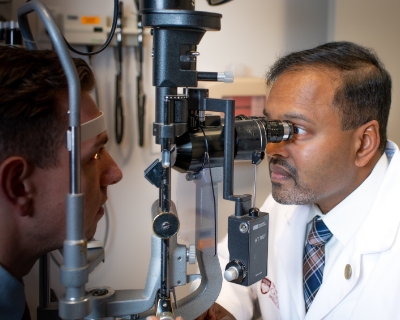
Cyclist Heinz Richardson’s future was on the line due to a rare eye condition. Thanks to ophthalmologist Seenu Hariprasad, MD, his future is brighter than before.
The receptionist at the University of Chicago Medical Center was taken aback by the tall, slender Englishman standing in front of her. Heinz Richardson, 59, was 2,000 miles into a charity bicycle tour that would take him from Portland, Ore. to Portland Place in London. But, somewhere in the middle of South Dakota, he started having trouble with his left eye. He just wanted to have it checked out before he rejoined his group and continued the journey back home.
"Do you have insurance?" the receptionist asked. Yes, but he couldn't remember the name of the company. Sizing up the challenge in front of her, the receptionist made a few phone calls. Thirty minutes later, Richardson was in front of an ophthalmologist. Seenu M. Hariprasad, MD, chief of vitreoretinal service at the University of Chicago, delivered a devastating diagnosis.
Dr. Hariprasad told Richardson that he had two choices: He could get on a plane to England that afternoon and get treatment at home or stay in America to receive a newly approved drug. With quick action, he might be able to save his sight. He had to make a choice, now. His future as an architect was on the line.
"I was very shocked," Richardson said. "When someone says you have a condition that is quite serious and you must do something quickly, and then we may be able to save your eyesight, you kind of hit the floor. I'm an architect, I need my eyesight. I needed this sorted as quick as possible."
One Eye Stroke, But Two Strokes of Luck

Seenu M. Hariprasad, MD, examines a patient's eyes
Richardson was actually lucky, in two ways. His wife had planned to meet him in Chicago, the half-way point in the 4,500-mile journey. When she arrived and he mentioned the trouble with his vision, she insisted he get it checked out in Chicago. The weather in South Dakota had been challenging. They cycled into the wind in pelting rain, dodging trucks. At first, he thought he had grit in his eye and tried washing it out with saline. It wasn't until he left the wide-open expanses of South Dakota that he really noticed the problems with his vision. In crowded Chicago, the vertical and horizontal lines on the tall buildings appeared wobbly and he had black spots in his field of vision. He figured he'd get it checked out once he was back in London. But his wife was "very persuasive." The University of Chicago Medical Center was not far from their hotel. "Why not set your mind at ease?" she asked.
The hospital they went to was not just convenient, it was top-notch. Dr. Hariprasad is a leading specialist in various retinal disorders, including the condition Richardson had developed, a retinal vein occlusion, a condition that happens when blood flow leaving the retina is blocked. The retina is a thin layer of tissue at the back of the eye that is crucial to good vision. When the waste blood can't leave the eye, fresh blood bringing oxygen and nutrients has trouble getting to the retina and the retinal cells become injured. The vessels also leak fluid that can cause water damage to the retina. It's painless, sudden, and if not treated early, can damage vision permanently.
Richardson had a specific type of vein occlusion called a hemiretinal vein occlusion. It affects half of the retina. About 60 to 70 percent of retinal vein occlusions involve less than half of the retina and are called branch retinal vein occlusions. Another 20 to 30 percent occur within the optic nerve and can affect the entire retina, they are called central retinal vein occlusions. Hemiretinal vein occlusions occur only 3 to 5 percent of the time, so his condition is quite rare.
Surprising Recovery
Two of the problems that a retinal vein occlusion can cause are swelling in the retina and the growth of new, abnormal blood vessels. The three main treatment options are:
- injections into the eye of a medicine that blocks the protein responsible for developing abnormal blood vessels and helps reduce retinal swelling,
- steroid injections to stop the swelling or
- laser treatment — called macular grid laser photocoagulation — to stop the fluid from leaking in the center of the retina.
Dr. Hariprasad estimates about 80 percent of patients in his practice get a combination of two of the three treatments. He chose to treat Richardson with a protein blocker or anti-VEGF medication. At the time, the FDA had just approved a new type of anti-VEGF. Experts like Dr. Hariprasad suspected that the new drug would be more effective because it seemed to remain in the eye longer.
It usually takes several injections over a few months before patients notice an improvement. But Richardson's vision improved dramatically in just one week, after one injection. Dr. Hariprasad scanned his eye twice. He couldn't believe the improvement. "You must have a remarkable ability to recover or you're incredibly fit," he said. "Well, I did just cycle 2,000 miles," Richardson deadpanned.
Richardson was surprising in another way. He didn't seem to have any of the classic risk factors for a retinal vein occlusion, like diabetes, high blood pressure, high cholesterol or heart disease. Dr. Hariprasad has a theory that the difficult stretch in South Dakota was the culprit. Though he was trekking through flat farmland, the headwinds made it feel like a constant, grueling uphill climb. The rain was unrelenting, so he didn't feel the need to drink much water. He was likely dehydrated, which may have caused the blood to thicken and clot. Dr. Hariprasad has treated other athletes with retinal vein occlusions; dehydration seemed to play a role in a number of these patients.
Crossing the Finish Line
Richardson is grateful he stayed in Chicago and was treated by Dr. Hariprasad. "He's an amazing guy, so warm and helpful, as he explained what was going on and the need to act quickly."
Though grateful, Richardson didn't exactly take all the doctor's advice. Dr. Hariprasad suggested he not rejoin the ride. But about a week later, he was on a plane to Pittsburgh, not London. Richardson finished the ride with his architect colleagues. They raised more than £130,000 for two charities: Article 25 and The Architects' Benevolent Society. The group was also gathering information about urban bicycling. Their ideas, data and solutions were published and distributed to Members of Parliament and the Mayor of London.
It has been about six years since his medical emergency, and Richardson's vision remains stable. Despite the distance, doctor and patient also remain friends.
"When taking a step back, Heinz's case is so important because he's a reminder of why we work hard seeing patients all day," Dr. Hariprasad said. "This is more than just a job, more than just sticking a needle in an eye — these human beings are our partners on Earth and patients can become lifelong friends. Enabling people to keep doing what they want to do is our purpose and mission in life. It's very special."